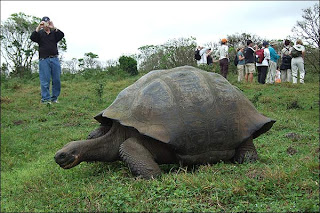La tortuga elefantina terrestre llega a medir 1,50 m de largo y puede pesar 250 kg. Se conocen dos especies muy parecidas que viven casi en las antípodas de nuestro planeta: en las islas Galápagos, frente a Ecuador, y en las islas Aldabra, en el océano Índico.
Su crecimiento no se detiene desde que nace hasta que muere. Puede superar los 180 años. Tiene una gran resistencia a la falta de agua y de comida: puede estar casi un año sin comer.
Pone entre dos y veinte huevos del tamaño de una pelota de tenis. Cubre el nido y deja los huevos que eclosionan a los seis meses. La temperatura del nido determina el sexo de las crías: a menor temperatura nacerán más machos.
Sus patas son fuertes y tienen garras, debido a que está adaptada para excavar los nidos donde depositará los huevos.
Tiene un caparazón alto y abovedado. Este posee una especie de bisagra que le permite cerrarlo por completo.
Se encuentran en peligro grave de extinción debido a que en las islas Galápagos se han introducido especies exóticas, es decir, ajenas a su ecosistema, que atentan contra su supervivencia. Por ejemplo, la rata de Noruega, que se come los huevos y crías, o el ganado caprino, que consume los mismos vegetales que ellas.
The elephantine terrestrial turtle grows to 1.50 m long and can weigh 250 kg. They know two very similar species living almost at the antipodes of our planet: in the Galapagos Islands, off Ecuador, and the Aldabra Islands in the Indian Ocean. Their growth is not stopped from birth to death. Can exceed 180 years. It is highly resistant to lack of water and food: it may be almost a year without eating. Put two to twenty eggs the size of a tennis ball. It covers the nest and let the eggs hatch in six months. The temperature of the nest determines the sex of offspring: a lower temperature more males born. His legs are strong and have claws, because it is adapted to excavate the nests where eggs deposited. It has a high vaulted shell. This has a hinge that allows you to close it completely. They are in serious danger of extinction because in the Galapagos Islands have been introduced exotic species, ie beyond its ecosystem, which threaten their survival. For example, the Norway rat, which eats the eggs and young, or goats, which consumes the same plant them.





No hay comentarios:
Publicar un comentario